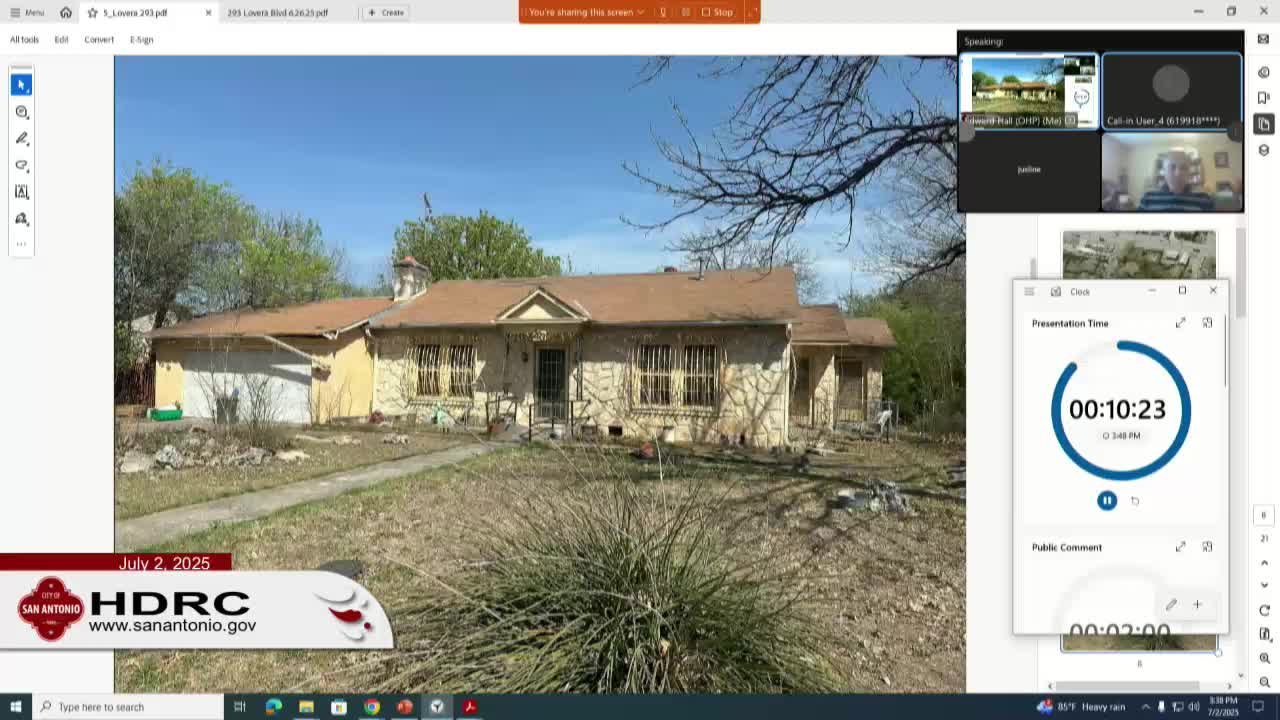Commission reviews historic home renovation plans in 1951 structure
July 02, 2025 | San Antonio, Bexar County, Texas
This article was created by AI summarizing key points discussed. AI makes mistakes, so for full details and context, please refer to the video of the full meeting. Please report any errors so we can fix them. Report an error »

In the heart of San Antonio, a recent meeting of the Historical Design and Review Commission unfolded, focusing on the preservation and restoration of a historic home. As members gathered, the atmosphere buzzed with anticipation, each participant keen to ensure that the integrity of the city's architectural heritage remained intact.
The discussion centered on a specific property, where the applicants sought approval for renovations that included the restoration of original stonework and the replacement of doors. Commission members raised critical questions about the plans, particularly regarding the historical accuracy of the proposed changes. One member pointed out the absence of a detailed site plan, which is essential for understanding how the spaces within the home are organized and how they relate to the original design.
The conversation took a turn when the topic of the home's stone facade arose. It was revealed that much of the original stone had deteriorated, prompting the need for repairs. The applicants assured the commission that the replacement stones would match the original pattern and placement, a commitment that seemed to satisfy some concerns. However, the commission emphasized the importance of restoring the facade to its former glory, ensuring that any changes would not detract from the home's historical significance.
As the meeting progressed, the dialogue shifted to the doors of the house. The applicants proposed to fill in two existing doorways, raising questions about their historical relevance. Commission members scrutinized the plans, referencing historical documents to clarify whether these doors were original features or later additions. The discussion highlighted the delicate balance between modernization and preservation, a theme that resonated throughout the meeting.
In a notable moment, the commission discussed the need for a site plan that included a new fence, which the applicants intended to replicate from a neighboring property. This detail underscored the commission's commitment to maintaining the aesthetic continuity of the neighborhood while allowing for necessary updates.
As the meeting drew to a close, it became clear that the commission's role is not just about approving renovations but also about safeguarding the stories embedded in San Antonio's architecture. The decisions made in these meetings will shape the city's landscape for generations to come, ensuring that the past is honored even as the future unfolds. The commitment to preserving the character of San Antonio remains strong, reflecting a community that values its history while embracing change.
The discussion centered on a specific property, where the applicants sought approval for renovations that included the restoration of original stonework and the replacement of doors. Commission members raised critical questions about the plans, particularly regarding the historical accuracy of the proposed changes. One member pointed out the absence of a detailed site plan, which is essential for understanding how the spaces within the home are organized and how they relate to the original design.
The conversation took a turn when the topic of the home's stone facade arose. It was revealed that much of the original stone had deteriorated, prompting the need for repairs. The applicants assured the commission that the replacement stones would match the original pattern and placement, a commitment that seemed to satisfy some concerns. However, the commission emphasized the importance of restoring the facade to its former glory, ensuring that any changes would not detract from the home's historical significance.
As the meeting progressed, the dialogue shifted to the doors of the house. The applicants proposed to fill in two existing doorways, raising questions about their historical relevance. Commission members scrutinized the plans, referencing historical documents to clarify whether these doors were original features or later additions. The discussion highlighted the delicate balance between modernization and preservation, a theme that resonated throughout the meeting.
In a notable moment, the commission discussed the need for a site plan that included a new fence, which the applicants intended to replicate from a neighboring property. This detail underscored the commission's commitment to maintaining the aesthetic continuity of the neighborhood while allowing for necessary updates.
As the meeting drew to a close, it became clear that the commission's role is not just about approving renovations but also about safeguarding the stories embedded in San Antonio's architecture. The decisions made in these meetings will shape the city's landscape for generations to come, ensuring that the past is honored even as the future unfolds. The commitment to preserving the character of San Antonio remains strong, reflecting a community that values its history while embracing change.
View full meeting
This article is based on a recent meeting—watch the full video and explore the complete transcript for deeper insights into the discussion.
View full meeting
